Several hundred anti-Macron Yellow Vest protesters returned to Paris and other French cities Saturday to continue their now two-month-long demonstration against the French government.
Update 2000 — Yellow Vests March Sees Fires, Teargas
The Associated Press brings this report from Paris:
French security forces fired tear gas and flash-balls after a march through picturesque central Paris went from peaceful to provocative Saturday as several thousand protesters staged the yellow vest movement’s first action of 2019 to keep up pressure on President Emmanuel Macron.
A river boat restaurant moored below the clashes on the Left Bank of the Seine River caught fire. Smoke and tear gas wafted above the Orsay Museum and the gold dome of the French Academy as riot police, nearly invisible at the start of the demonstration, moved front and center when protesters deviated from an officially approved path.
Police boats patrolled the river while beyond the Seine, motorcycles and a car were set on fire on the Boulevard Saint Germain, a main Left Bank thoroughfare. Riot police and firefighters moved in, and barricades mounted in the middle of the wide street also glowed in orange flames.
Protesters made their way to the Champs-Elysees Avenue, the famed boulevard that has been at the center of previous yellow vest demonstrations, many removing their distinctive vests and mixing with shoppers.
Riot police moved in with a water cannon to evacuate the avenue. A line of parked cars burned on a nearby street.
In a first, the building housing the office of the French government spokesman was attacked. Government spokesman Benjamin Griveaux was evacuated from his Left Bank office at the Ministry for Parliamentary Relations after the front door of the building was partially destroyed.
“It wasn’t me who was attacked … It was the institutions, the democratic form of government,” Griveaux said later, explaining on French TV that he and a half-dozen colleagues were taken out a back door while a group attacked the front door with construction equipment.
Those who did this “attacked the house of France,” he said.
It was the first such attack on government property since the yellow vest movement began weekly protests eight Saturdays ago, in mid-November. Protesters have tried to reach the presidential Elysee Palace, which is protected like a bunker.
Saturday’s march had been declared in advance and approved, in contrast to some illegal December demonstrations that degenerated into vandalism, looting and chaos.
The latest demonstration was a sort of test of the movement’s staying power after proposals by Macron to address concerns of the French who have a hard time making ends meet, including canceling the fuel tax hikes at the origin of the protests.
Interior Minister Christophe Castaner estimated that about 50,000 people participated in protests around France on Saturday. Police counted some 3,500 protesters in Paris.
The atmosphere was initially calm in the French capital, but turned when some protesters tried to cross the river on a pedestrian bridge not on the official route from City Hall to the National Assembly, the lower house of parliament. Police used clubs and tear gas, then held the bridge in a standoff while violence broke out.
Video on French TV showed a man repeatedly stomping on an officer in riot gear on the ground and hitting the shield of another officer.
Some confrontations took place in other cities around France, with tear gas fired in Bordeaux and in Rouen in Normandy.
Protesters were looking to breathe new life into the yellow vest movement, named after the fluorescent protective gear French motorists must keep in their cars. The protests were launched in anger over fuel tax hikes, but have swelled with broader anger over Macron’s economic policies, deemed to favor the rich.
On Saturday, protesters reiterated a call for Macron to resign.
“Resolution 2019: Demacronize,” read one sign. “Power to the people,” read another.
Government spokesman Griveaux had said on Friday that those who show up to protest “want insurrection” as the movement appears to wane and radicalize.
He called on the French people to express their views during an upcoming “national debate” rather than by taking to the streets.
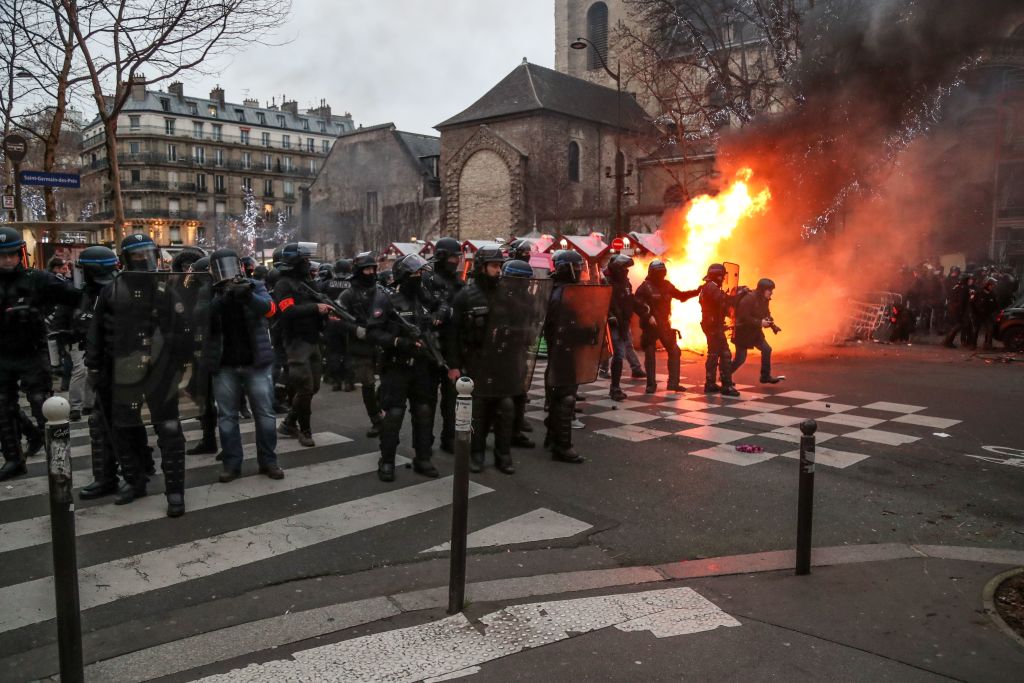
Security personnel form a line near a Christmas Market on a street in Paris on January 5, 2019, as fires burn during clashes between yellow vest “Gilets Jaunes” anti-government protestors. – France’s “yellow vest” protestors were back on the streets again as a government spokesman denounced those still protesting as hard-liners who wanted only to bring down the government. Several hundred protestors gathered on the Champs Elysees in central Paris, where around 15 police wagons were also deployed, an AFP journalist said. Marches were underway in several other cities across France. (Photo by Zakaria ABDELKAFI / AFP) (Photo credit should read ZAKARIA ABDELKAFI/AFP/Getty Images)
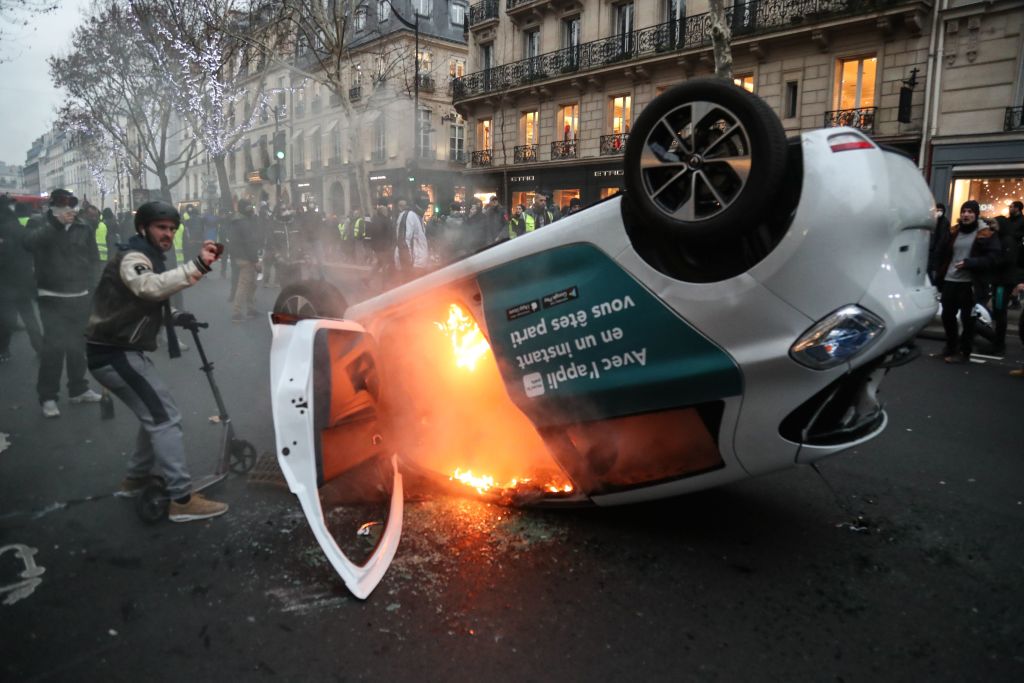
A vehicle burns on a street in Paris on January 5, 2019, during clashes between yellow vest “Gilets Jaunes” anti-government protestors and security personnel. – France’s “yellow vest” protestors were back on the streets again as a government spokesman denounced those still protesting as hard-liners who wanted only to bring down the government. Several hundred protestors gathered on the Champs Elysees in central Paris, where around 15 police wagons were also deployed, an AFP journalist said. Marches were underway in several other cities across France. (Photo by Zakaria ABDELKAFI / AFP) (Photo credit should read ZAKARIA ABDELKAFI/AFP/Getty Images)

Riot police officers walk towards a burning barricade in Paris on January 5, 2019 during an anti-government demonstration called by the yellow vest “Gilets Jaunes” movement. – France’s “yellow vest” protestors were back on the streets again as a government spokesman denounced those still protesting as hard-liners who wanted only to bring down the government. Several hundred protestors gathered on the Champs Elysees in central Paris, where around 15 police wagons were also deployed, an AFP journalist said. Marches were underway in several other cities across France. (Photo by Eric FEFERBERG / AFP) (Photo credit should read ERIC FEFERBERG/AFP/Getty Images)
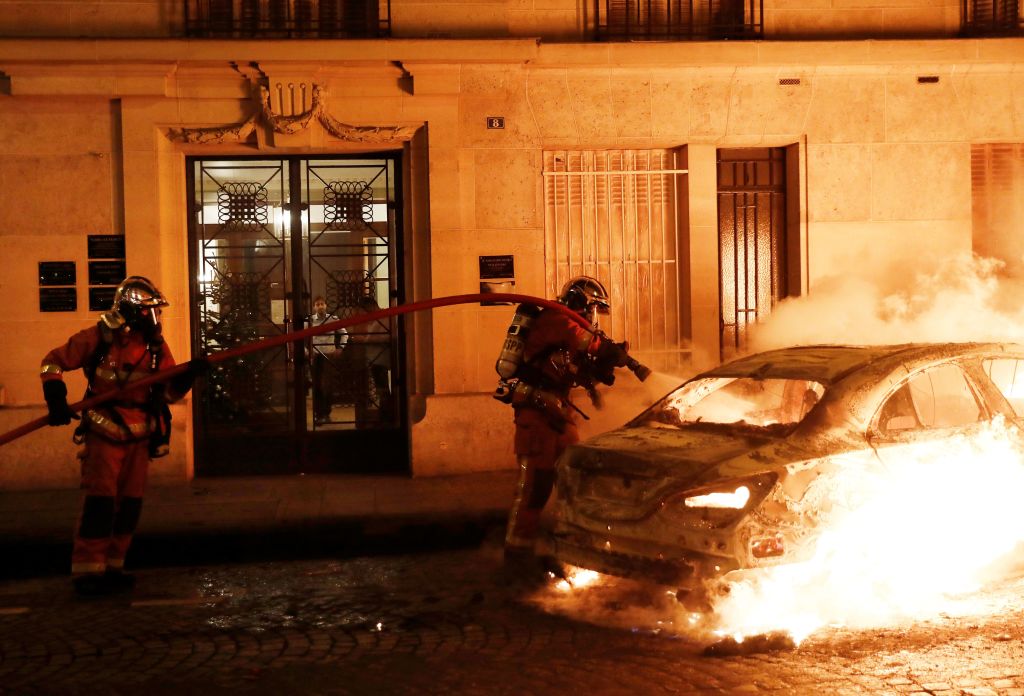
Firefighters trie to extinguish a burning car in a street of Paris on January 5, 2019 during an anti-government demonstration called by the yellow vest “Gilets Jaunes” movement. – France’s “yellow vest” protestors were back on the streets again as a government spokesman denounced those still protesting as hard-liners who wanted only to bring down the government. Several hundred protestors gathered on the Champs Elysees in central Paris, where around 15 police wagons were also deployed, an AFP journalist said. Marches were underway in several other cities across France. (Photo by Sameer Al-Doumy / AFP) (Photo credit should read SAMEER AL-DOUMY/AFP/Getty Images)
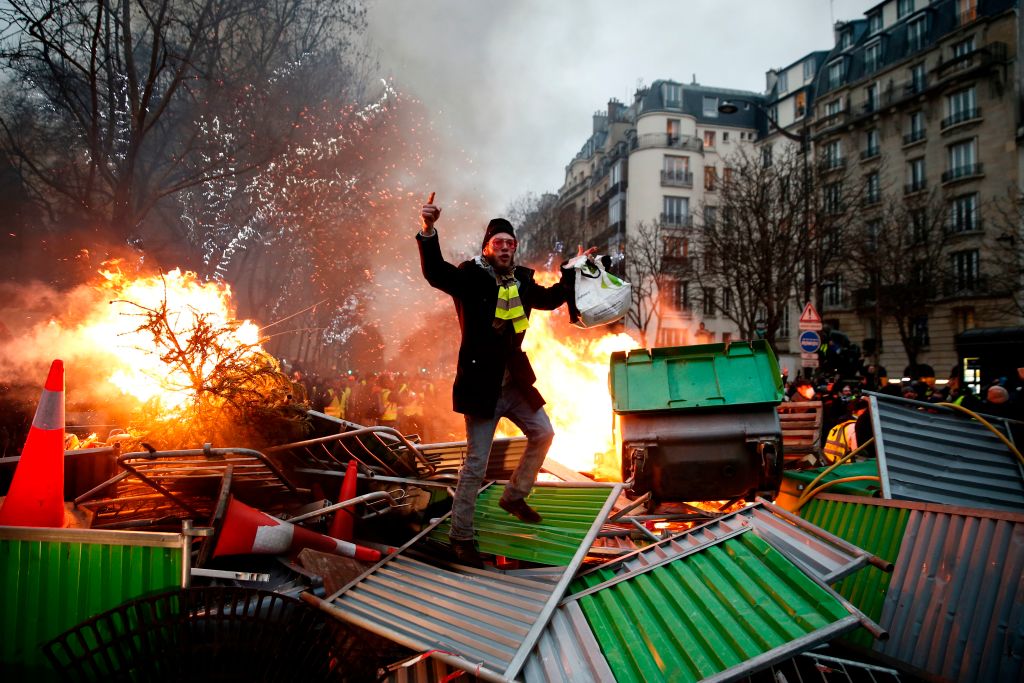
TOPSHOT – A demonstrator gestures on a burning barricade on January 5, 2019 in Paris, during an anti-government demonstration called by the yellow vest “Gilets Jaunes” movement. – France’s “yellow vest” protestors were back on the streets again as a government spokesman denounced those still protesting as hard-liners who wanted only to bring down the government. Several hundred protestors gathered on the Champs Elysees in central Paris, where around 15 police wagons were also deployed, an AFP journalist said. Marches were underway in several other cities across France. (Photo by Abdul ABEISSA / AFP) (Photo credit should read ABDUL ABEISSA/AFP/Getty Images)
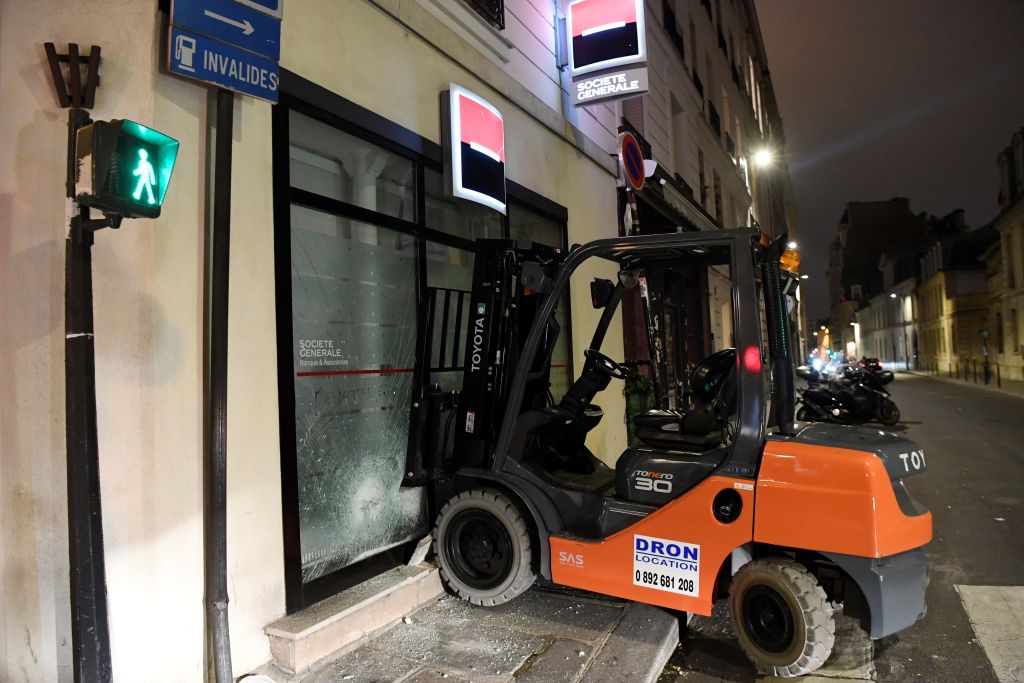
A forklift is picture after it has been used to destroy the shop window of a Societe Generale bank branch on January 5, 2019 in Paris, on the sidelines of a demonstration called by the yellow vests (gilets jaunes) movement for the eighth week in a row of nationwide protest against high cost of living, government tax reforms and for more “social and economic justice.” (Photo by Bertrand GUAY / AFP)

Riot police officers stand on the Champs-Elysees avenue in Paris during an anti-government demonstration called by the yellow vest “Gilets Jaunes” movement on January 5, 2019. – France’s “yellow vest” protestors were back on the streets again as a government spokesman denounced those still protesting as hard-liners who wanted only to bring down the government. Several hundred protestors gathered on the Champs Elysees in central Paris, where around 15 police wagons were also deployed, an AFP journalist said. Marches were underway in several other cities across France. (Photo by Geoffroy VAN DER HASSELT / AFP) (Photo credit should read GEOFFROY VAN DER HASSELT/AFP/Getty Images)
Read the original story below:
Launched in November over French President Macron’s attempt to pursue green policies by making car ownership unaffordable through punitive fuel taxes, the Yellow Vest movement has since transformed into a broader protest group that pulls in activists from across the political spectrum.
One of the key demands now being pushed by protesters after Macron bowed to pressure in December and gave in on the green taxes is the introduction of so-called Citizen Initiative Referendums, or ‘RIC’.
Under the plans called for by the marchers, any petition in France that gained 700,000 signatures would be legally required to be put to a binding national referendum, with politicians forced to honour the results. The votes could be used to create or change laws, amend the constitution, and even fire the President.
New polling this week revealed the French public overwhelmingly support the idea, which if implemented would have the impact of dramatically reducing the power of politicians and handing it to the people. Some 80 per cent of French are thought to support of the initiative, while 47 per cent believed the Macron government was going to ignore the public.
Now in its eighth week, Saturday’s march saw fewer marchers than the tens of thousands seen nationwide in November, but also less of the violence that has marred some marches. Some political observers including populist leader Marion Marechal have suggested the violence was visited upon the marches by hard-left agent provocateurs using the grassroots movement as a pretext for violence.
Ahead of the protest on Friday, government spokesman Benjamin Griveaux criticised the movement, saying those taking to the streets are “agitators who want insurrection and, basically, to overthrow the government.”
Anger among the protesters intensified this week after prominent Yellow Vest organiser Eric Drouet was arrested by police who said he’d organised an illegal demonstration. So far 216 Yellow Vest activists are in jail either sentenced or awaiting trial, and over 4,5000 were arrested in relation to the protests in 2018.
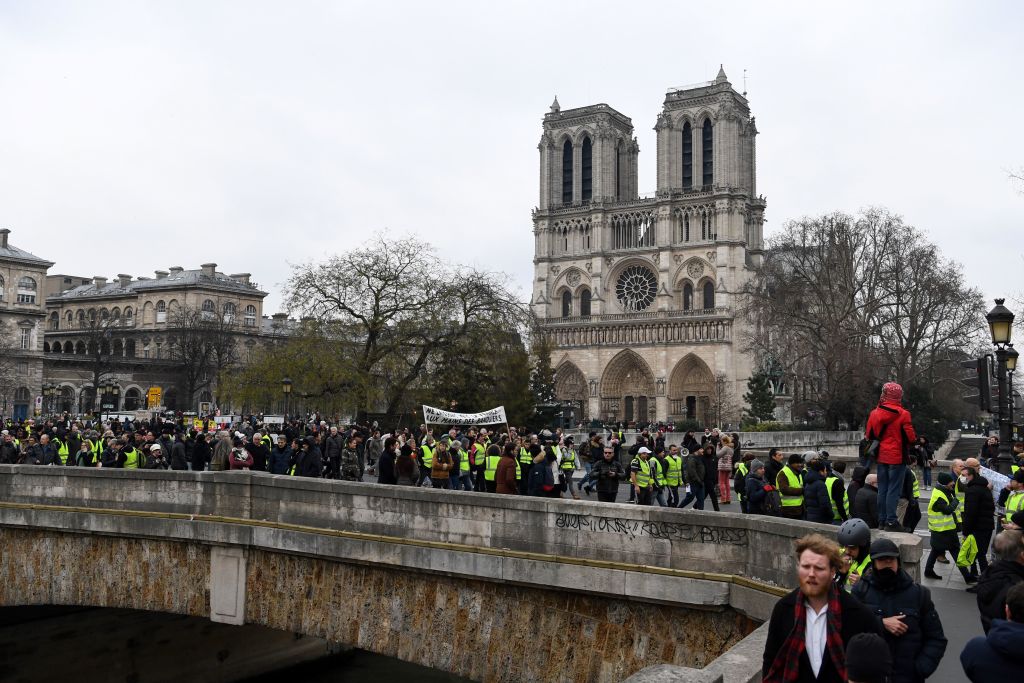
Yellow vest protestors walk in front of Notre-Dame cathedral in Paris on January 5, 2019, during a rally by yellow vest “Gilets Jaunes” anti-government protestors. – Over the past six weeks, “yellow vest” demonstrators — so-called after the high-visibility jackets they wear — have repeatedly clashed with police in Paris and other big cities, plunging Macron’s presidency into crisis. The “yellow vest” movement began in rural France over fuel taxes and quickly ballooned into a wider revolt against the 41-year-old president’s pro-business policies and perceived arrogance by low-paid workers and pensioners. (Photo by ERIC FEFERBERG / AFP)

“Yellow Vest” (Gilets jaunes) anti-government protester gather material as they construct a barricade during a rally in Nantes on January 5, 2019, part of a nationwide day of demonstrations. – France’s “yellow vest” protestors were back on the streets as a government spokesman denounced those still protesting as hard-liners who wanted only to bring down the government. Several hundred protestors gathered on the Champs Elysees in central Paris, where around 15 police wagons were also deployed, an AFP journalist said. Marches were underway in several other cities across France. (Photo by LOIC VENANCE / AFP)
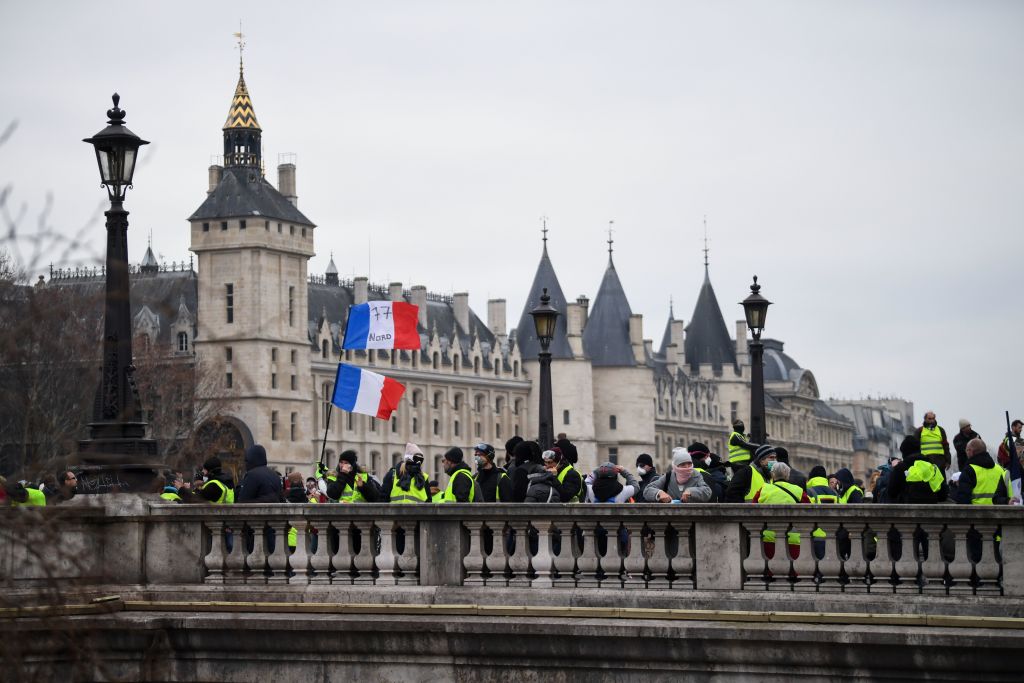
Anti-government yellow vest protestors demonstrate in Paris on January 5, 2019. – Over the past six weeks, “yellow vest” demonstrators — so-called after the high-visibility jackets they wear — have repeatedly clashed with police in Paris and other big cities, plunging Macron’s presidency into crisis. The “yellow vest” movement began in rural France over fuel taxes and quickly ballooned into a wider revolt against the 41-year-old president’s pro-business policies and perceived arrogance by low-paid workers and pensioners. (Photo by Eric FEFERBERG / AFP)
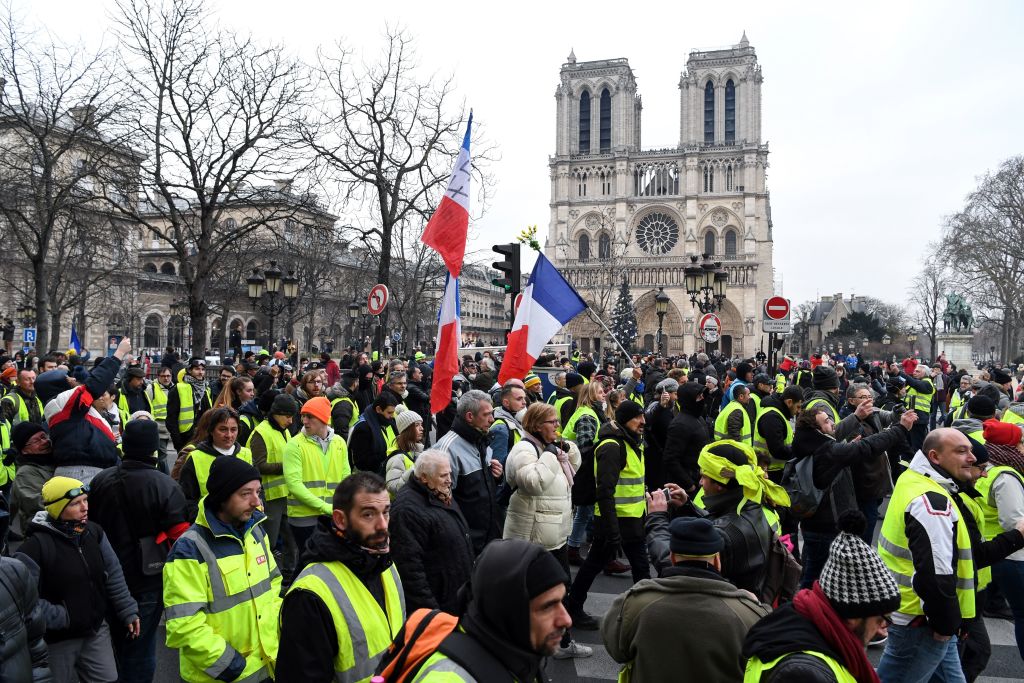
Yellow vest protestors walk in front of Notre-Dame cathedral in Paris on January 5, 2019, during a rally by yellow vest “Gilets Jaunes” anti-government protestors. – Over the past six weeks, “yellow vest” demonstrators — so-called after the high-visibility jackets they wear — have repeatedly clashed with police in Paris and other big cities, plunging Macron’s presidency into crisis. The “yellow vest” movement began in rural France over fuel taxes and quickly ballooned into a wider revolt against the 41-year-old president’s pro-business policies and perceived arrogance by low-paid workers and pensioners. (Photo by ERIC FEFERBERG / AFP)
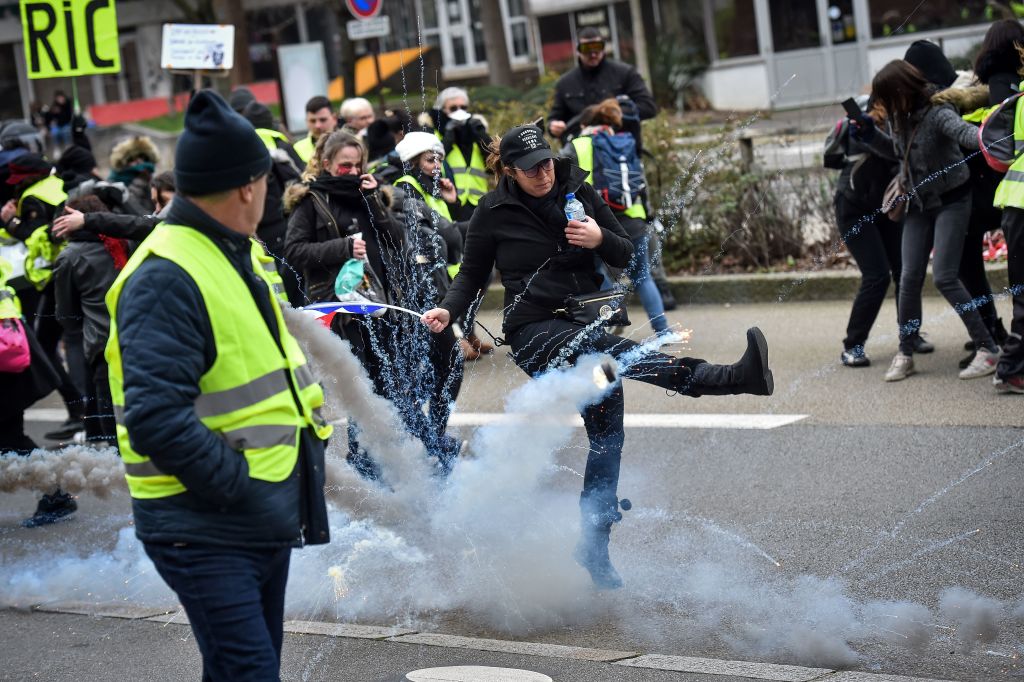
A “Yellow Vest” (Gilets jaunes) anti-government protester kicks a teargas shell during a rally in Nantes on January 5, 2019, during a nationwide day of demonstrations. – France’s “yellow vest” protestors were back on the streets as a government spokesman denounced those still protesting as hard-liners who wanted only to bring down the government. Several hundred protestors gathered on the Champs Elysees in central Paris, where around 15 police wagons were also deployed, an AFP journalist said. Marches were underway in several other cities across France. (Photo by LOIC VENANCE / AFP)
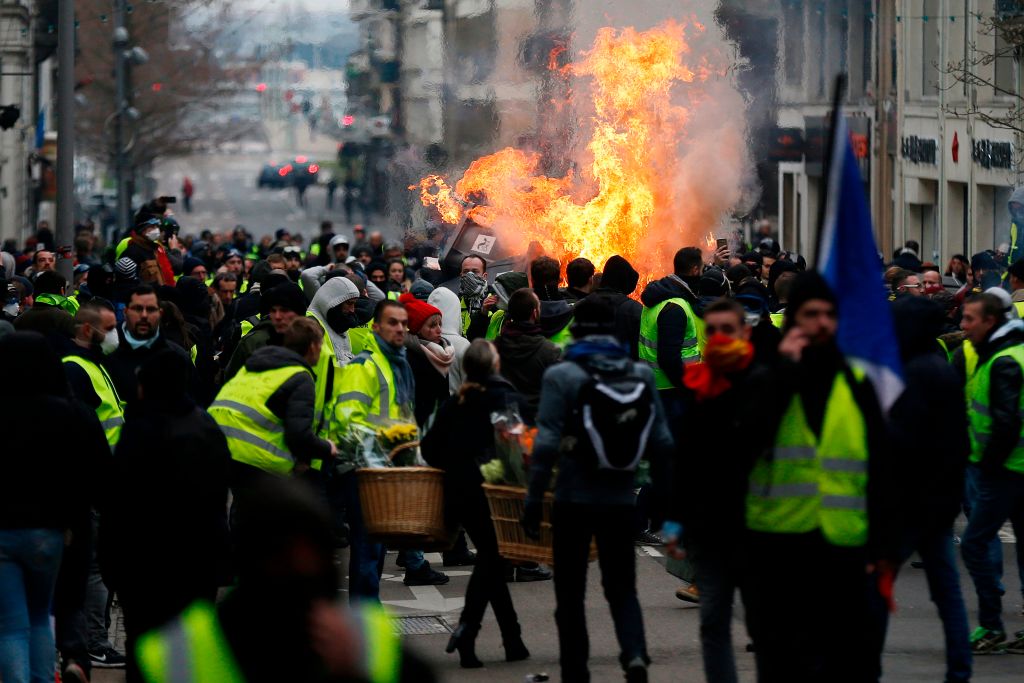
“Yellow Vest” (Gilets jaunes) anti-government protesterswalk with burning material on a street in Rouen, north-western France on January 5, 2019, during a nationwide day of demonstrations. – France’s “yellow vest” protestors were back on the streets as a government spokesman denounced those still protesting as hard-liners who wanted only to bring down the government. Several hundred protestors gathered on the Champs Elysees in central Paris, where around 15 police wagons were also deployed, an AFP journalist said. Marches were underway in several other cities across France. (Photo by CHARLY TRIBALLEAU / AFP)

“Yellow Vest” (Gilets jaunes) anti-government protesters gather near a burning ‘wheelie bin’ on a street in Rouen, north-western France on January 5, 2019, during a nationwide day of demonstrations. – France’s “yellow vest” protestors were back on the streets as a government spokesman denounced those still protesting as hard-liners who wanted only to bring down the government. Several hundred protestors gathered on the Champs Elysees in central Paris, where around 15 police wagons were also deployed, an AFP journalist said. Marches were underway in several other cities across France. (Photo by CHARLY TRIBALLEAU / AFP)
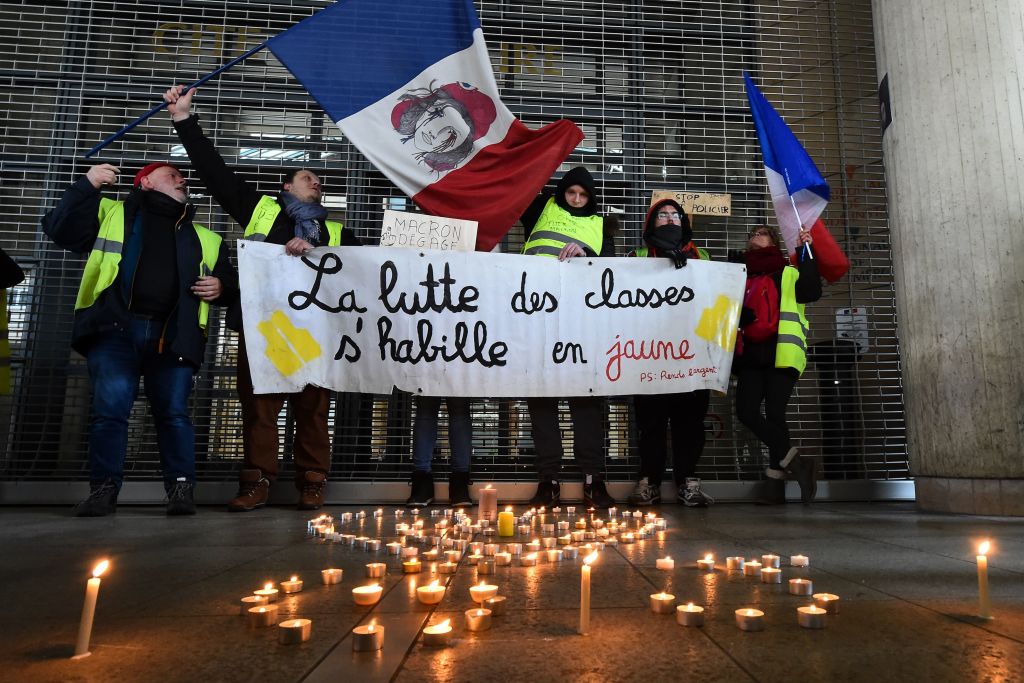
Yellow vest “Gilets Jaunes” protestors hold a French flag and a banner reading “class struggle is wearing yellow” as they staged a vigil during a rally by anti-government protestors on January 5, 2019 in front of the Law Court of Le Mans, northwestern France. – Over the past six weeks, “yellow vest” demonstrators — so-called after the high-visibility jackets they wear — have repeatedly clashed with police in Paris and other big cities, plunging Macron’s presidency into crisis. The “yellow vest” movement began in rural France over fuel taxes and quickly ballooned into a wider revolt against the 41-year-old president’s pro-business policies and perceived arrogance by low-paid workers and pensioners. (Photo by JEAN-FRANCOIS MONIER / AFP)

Yellow vest protestors gather outside the City Hall (hotel de ville) in Paris on January 5, 2019, during a rally by yellow vest “Gilets Jaunes” anti-government protestors. – Over the past six weeks, “yellow vest” demonstrators — so-called after the high-visibility jackets they wear — have repeatedly clashed with police in Paris and other big cities, plunging Macron’s presidency into crisis. The “yellow vest” movement began in rural France over fuel taxes and quickly ballooned into a wider revolt against the 41-year-old president’s pro-business policies and perceived arrogance by low-paid workers and pensioners. (Photo by ERIC FEFERBERG / AFP)
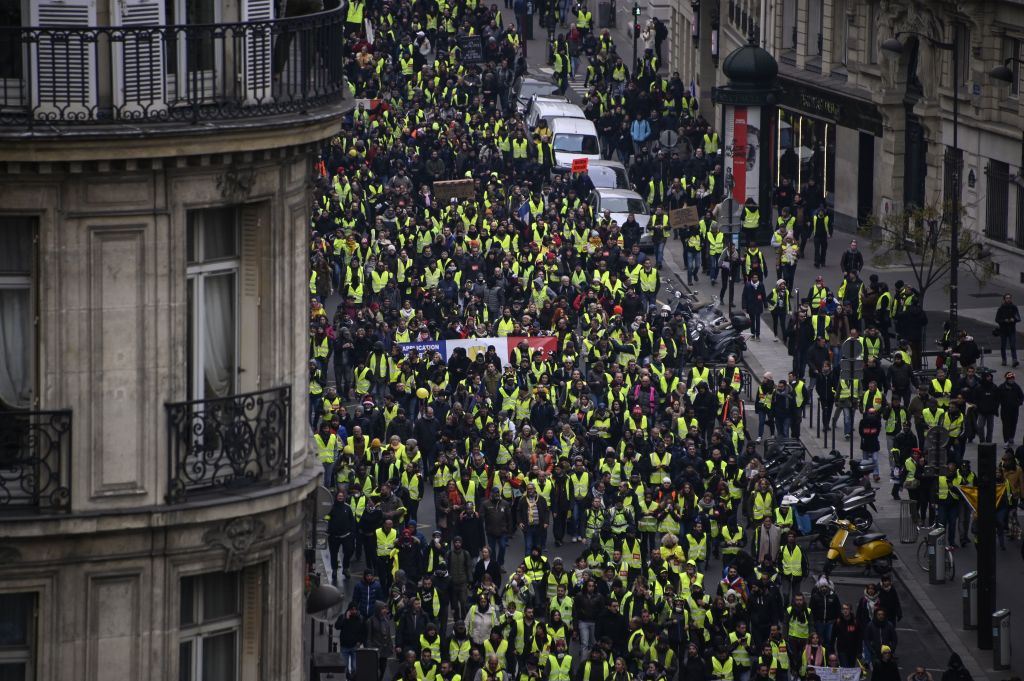
TOPSHOT – Yellow vest “Gilets Jaunes” march along Rue Quatre September in Paris on January 5, 2019, during a rally by the anti-government protestors. – France’s “yellow vest” protestors were back on the streets as a government spokesman denounced those still protesting as hard-liners who wanted only to bring down the government. Several hundred protestors gathered on the Champs Elysees in central Paris, where around 15 police wagons were also deployed, an AFP journalist said. Marches were underway in several other cities across France. (Photo by Olivier MORIN / AFP)
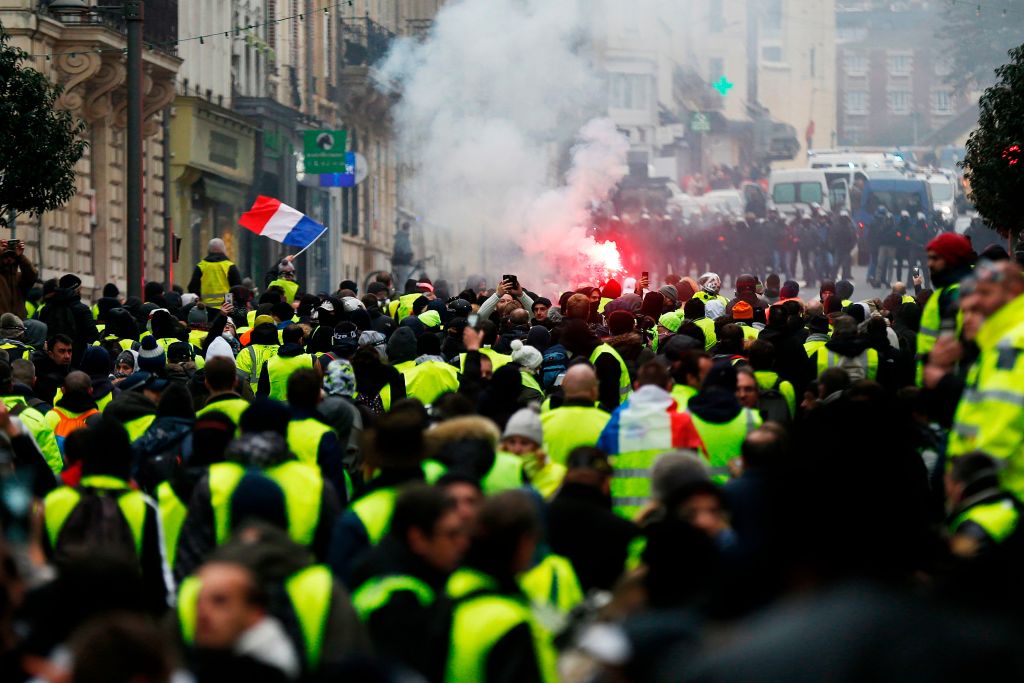
“Yellow Vest” (Gilets jaunes) anti-government protesters stage a rally in Rouen, north-western France on January 5, 2019, during a nationwide day of demonstrations. – France’s “yellow vest” protestors were back on the streets as a government spokesman denounced those still protesting as hard-liners who wanted only to bring down the government. Several hundred protestors gathered on the Champs Elysees in central Paris, where around 15 police wagons were also deployed, an AFP journalist said. Marches were underway in several other cities across France. (Photo by CHARLY TRIBALLEAU / AFP)

A “Yellow Vest” (Gilets jaunes) anti-government protester is struck by security personnel in Rouen, north-western France on January 5, 2019, during a nationwide day of demonstrations. – France’s “yellow vest” protestors were back on the streets as a government spokesman denounced those still protesting as hard-liners who wanted only to bring down the government. Several hundred protestors gathered on the Champs Elysees in central Paris, where around 15 police wagons were also deployed, an AFP journalist said. Marches were underway in several other cities across France. (Photo by CHARLY TRIBALLEAU / AFP)

Yellow vest protestors hold hands across a street in front of a line of security personnel in Paris on January 5, 2019, during a rally by yellow vest “Gilets Jaunes” anti-government protestors. – Over the past six weeks, “yellow vest” demonstrators — so-called after the high-visibility jackets they wear — have repeatedly clashed with police in Paris and other big cities, plunging Macron’s presidency into crisis. The “yellow vest” movement began in rural France over fuel taxes and quickly ballooned into a wider revolt against the 41-year-old president’s pro-business policies and perceived arrogance by low-paid workers and pensioners. (Photo by Lucas BARIOULET / AFP)

Yellow vest “Gilets Jaunes” anti-government protestors walk during a rally in Paris on January 5, 2019. – Over the past six weeks, “yellow vest” demonstrators — so-called after the high-visibility jackets they wear — have repeatedly clashed with police in Paris and other big cities, plunging Macron’s presidency into crisis. The “yellow vest” movement began in rural France over fuel taxes and quickly ballooned into a wider revolt against the 41-year-old president’s pro-business policies and perceived arrogance by low-paid workers and pensioners. (Photo by Lucas BARIOULET / AFP)

Yellow vest “Gilets Jaunes” anti-government protestors walk behind a banner during a rally in Paris on January 5, 2019. – Over the past six weeks, “yellow vest” demonstrators — so-called after the high-visibility jackets they wear — have repeatedly clashed with police in Paris and other big cities, plunging Macron’s presidency into crisis. The “yellow vest” movement began in rural France over fuel taxes and quickly ballooned into a wider revolt against the 41-year-old president’s pro-business policies and perceived arrogance by low-paid workers and pensioners. (Photo by Lucas BARIOULET / AFP)
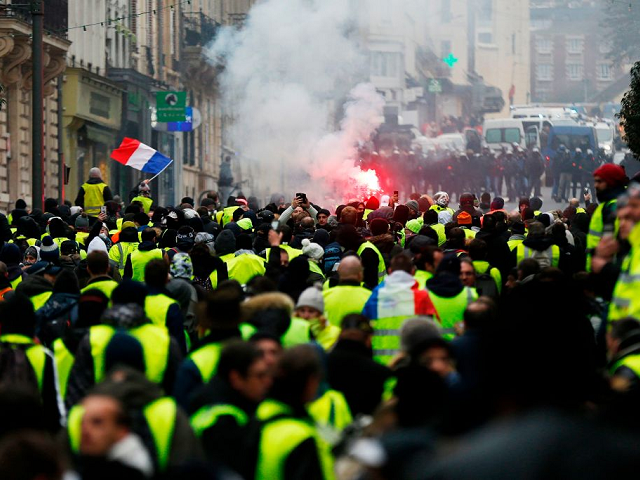
COMMENTS
Please let us know if you're having issues with commenting.